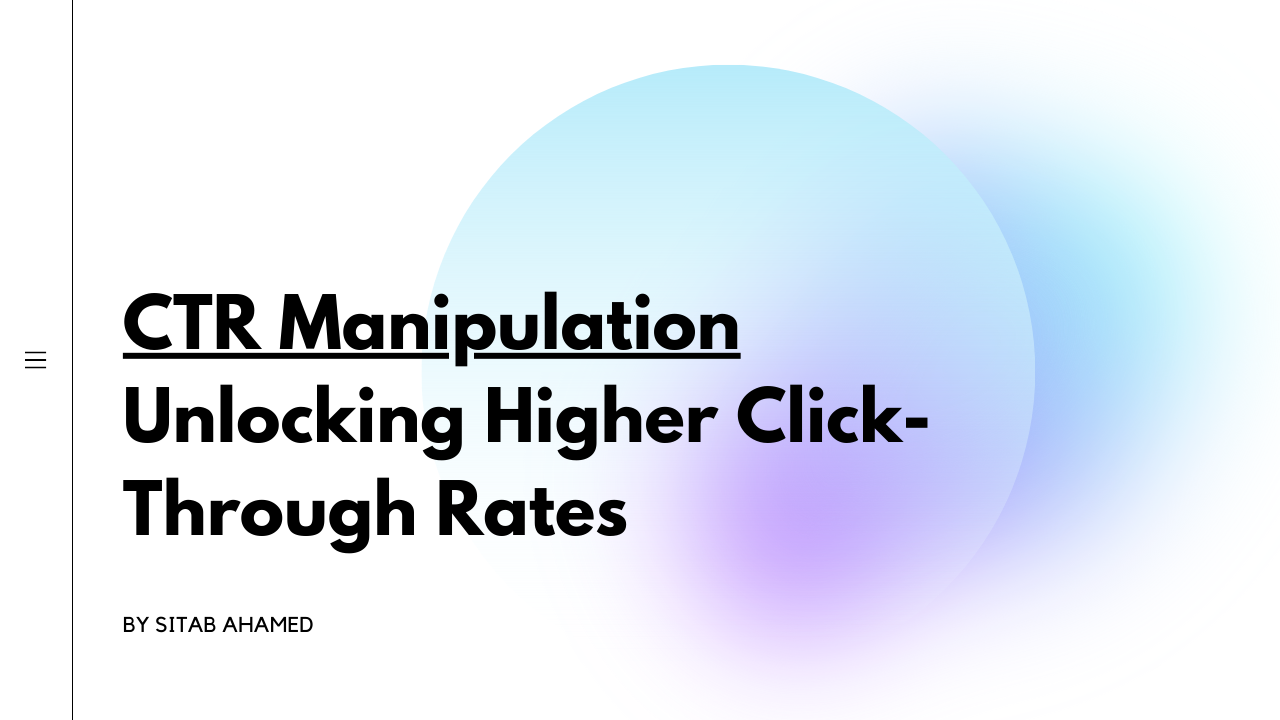Taking Full Advantage Of Impact with CTR Manipulation Press Release Strategies
Taking Full Advantage Of Impact with CTR Manipulation Press Release Strategies
Blog Article
Increase Your Traffic With Smart CTR Manipulation Strategies
In a significantly competitive electronic landscape, properly boosting your web traffic hinges on understanding click-through rate (CTR) adjustment techniques. A/B testing allows for exact adjustments based on real user actions, which can significantly boost your involvement metrics.
Recognizing Click-Through Rate

Comprehending the variables affecting CTR is essential for enhancing advertising efforts. Components such as advertisement target market, layout, and positioning targeting play substantial duties in establishing CTR. Advertisements placed in prime areas on a web page or those that are aesthetically attractive tend to attract even more clicks. Furthermore, the significance of the advertisement to its target market can significantly impact engagement, highlighting the relevance of comprehensive marketing research.
Moreover, tracking CTR in time permits marketers to analyze the efficiency of different projects and make data-driven changes. By examining patterns and patterns, companies can refine their strategies, eventually bring about enhanced user engagement and improved conversion prices. For that reason, a detailed understanding of CTR is vital for any kind of successful online advertising and marketing campaign.
Crafting Compelling Headings
While effective advertising techniques hinge on various elements, crafting compelling headings stands apart as a critical component that can considerably affect click-through prices. A heading functions as the impression of your material, and its ability to engage prospective visitors directly influences their decision to click.
To develop an efficient headline, take into consideration the following strategies. Use expressive and powerful language that stirs interest or feeling. Words like "utmost," "essential," or "revealed" can stimulate passion and punctual action. Second, keep your headlines succinct yet descriptive; a good guideline is to aim for about 60 personalities to make sure complete exposure on search engines.
Additionally, incorporating numbers or listings can boost quality and make your content show up more absorbable. "5 Tips for Boosting Your Traffic" is attractive and uncomplicated. Consider the target audience's requirements and interests, tailoring headlines to resonate with their certain desires or pain factors.
Using Aesthetic Aspects
Continually including aesthetic aspects right into your advertising approach can significantly boost engagement and improve click-through rates. Visuals such as video clips, pictures, and infographics capture interest better than text alone. They work as compelling devices that damage up thick web content, making it more absorbable and welcoming for customers.
Top notch photos relevant to your material can evoke feelings and create a stronger connection with your target market. Furthermore, infographics can provide complicated data in an easily easy to understand layout, allowing customers to understand key info swiftly. Videos, on the various other hand, are particularly powerful in communicating messages and can lead to higher retention rates amongst viewers.
Furthermore, the calculated use shades and layout components can influence customer actions. Appealing colors can direct an individual's eye toward certain phone call to activity, while consistent branding promotes recognition and trust fund. Ensure that your aesthetic web content is optimized for different devices, as mobile individuals constitute a considerable part of internet website traffic.
Executing A/B Examining
After developing a visually appealing advertising technique, the next step entails adjust these aspects with A/B testing. CTR Manipulation. This method, also recognized as split testing, allows online marketers to recommended you read contrast two versions of a digital possession-- be it an e-mail, touchdown page, or advertisement-- to identify which does much better in regards to click-through rate (CTR)
To implement A/B screening efficiently, start by recognizing a certain component to test, such as headlines, photos, or call-to-action buttons. It is critical to isolate one variable at once to accurately assess its effect on user behavior. Next off, produce two variants: the control (A) and the version (B) Ensure that both variations are displayed to a similar audience under the same problems to eliminate predisposition.
After gathering data over a predetermined timeframe, examine the results to figure out which version yielded a higher CTR. The understandings acquired from A/B screening can notify future advertising methods and drive continuous renovation in user interaction, eventually boosting total website traffic.
Assessing and Adjusting Techniques

When the information is accumulated, it is essential to determine patterns and fads that arise from the outcomes. If a specific call-to-action regularly outperforms others, it may call for a lot more famous positioning or larger application throughout campaigns. Furthermore, market understandings can guide future targeting methods, guaranteeing that messages are customized to the choices of particular audience sections.
Adjustments ought to be iterative, entailing continual testing and re-evaluation. Applying adjustments based this website on A/B testing is not a single initiative; it requires continuous tracking and adaptation to keep optimum performance. By cultivating a society of data-driven decision-making, marketers can successfully improve their click-through prices, eventually driving higher website traffic and conversions. In this dynamic electronic landscape, agility and responsiveness are extremely important for sustained success.

Conclusion
In verdict, reliable traffic improvement through click-through price control requires a multifaceted approach. By understanding the complexities of click-through prices, crafting engaging headings, using engaging aesthetic aspects, and carrying out A/B testing, a data-driven technique can be established. Continuous evaluation and change of strategies based on individual actions are vital for optimizing results. Ultimately, these techniques assemble to raise website traffic and conversions, underscoring the value of a organized and analytical technique in electronic advertising efforts.
Click-through rate (CTR) serves as an important metric that assesses the performance of online advertising projects, embodying the connection between ad visibility and customer interaction. It stands for the percentage you can find out more of users that click on a details link or promotion contrasted to the total number of individuals who see it. By examining patterns and fads, services can improve their approaches, eventually leading to enhanced customer interaction and boosted conversion rates. The insights obtained from A/B screening can educate future marketing techniques and drive constant improvement in customer involvement, inevitably improving overall website traffic.
Key metrics such as conversion rates, interaction degrees, and individual feedback need to be thoroughly assessed to educate choices.
Report this page